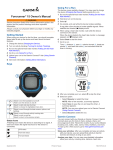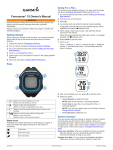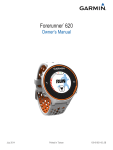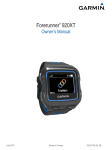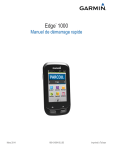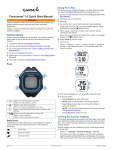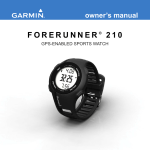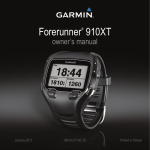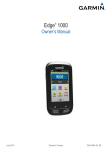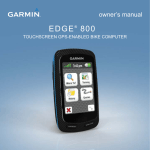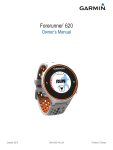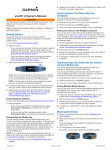Download Forerunner® 220 - Nav
Transcript
Forerunner 220 ® Owner’s Manual September 2014 Printed in Taiwan 190-01632-00_0C All rights reserved. Under the copyright laws, this manual may not be copied, in whole or in part, without the written consent of Garmin. Garmin reserves the right to change or improve its products and to make changes in the content of this manual without obligation to notify any person or organization of such changes or improvements. Go to www.garmin.com for current updates and supplemental information concerning the use of this product. Garmin®, the Garmin logo, Auto Lap®, Auto Pause®, Forerunner®, and Virtual Partner® are trademarks of Garmin Ltd. or its subsidiaries, registered in the USA and other countries. ANT+™, Garmin Connect™, and Garmin Express™ are trademarks of Garmin Ltd. or its subsidiaries. These trademarks may not be used without the express permission of Garmin. The Bluetooth® word mark and logos are owned by the Bluetooth SIG, Inc. and any use of such marks by Garmin is under license. Mac® is a registered trademark of Apple Computer, Inc. Windows® and Windows NT® are registered trademarks of Microsoft Corporation in the United States and other countries. Other trademarks and trade names are those of their respective owners. This product is ANT+™ certified. Visit www.thisisant.com/directory for a list of compatible products and apps. Table of Contents Introduction.................................................................... 1 Getting Started ........................................................................... 1 Keys ........................................................................................... 1 Status Icons .......................................................................... 1 Going for a Run .......................................................................... 1 Using Garmin Connect ............................................................... 1 Garmin Connect .................................................................... 1 Bluetooth Connected Features ............................................. 2 Charging the Device .................................................................. 2 Training ........................................................................... 2 Workouts .................................................................................... 2 Following a Workout From the Web ...................................... 2 Starting a Workout ................................................................ 2 About the Training Calendar ................................................. 2 Interval Workouts ....................................................................... 3 Creating an Interval Workout ................................................ 3 Starting an Interval Workout .................................................. 3 Stopping an Interval Workout ................................................ 3 Personal Records ...................................................................... 3 Viewing Your Personal Records ........................................... 3 Clearing a Personal Record .................................................. 3 Restoring a Personal Record ................................................ 3 Clearing All Personal Records .............................................. 3 Cleaning the Device .............................................................. 7 Caring for the Heart Rate Monitor ......................................... 7 Heart Rate Monitor Battery ................................................... 7 Troubleshooting............................................................. 7 Support and Updates ................................................................. 7 Getting More Information ........................................................... 7 Resetting the Device .................................................................. 7 Clearing User Data .................................................................... 7 Restoring All Default Settings .................................................... 7 Viewing Device Information ....................................................... 7 Updating the Software ............................................................... 7 Maximizing Battery Life .............................................................. 7 Switching to Watch Mode ...................................................... 8 Turning Off the Device .......................................................... 8 Appendix.........................................................................8 Heart Rate Zone Calculations .................................................... 8 Data Fields ................................................................................. 8 Software License Agreement ..................................................... 8 Index................................................................................9 ANT+™ Sensors............................................................. 3 Putting On the Heart Rate Monitor ............................................. 3 Setting Your Heart Rate Zones ............................................. 3 Tips for Erratic Heart Rate Data ............................................ 4 Pairing Your ANT+ Sensors ....................................................... 4 Foot Pod .................................................................................... 4 Going for a Run Using a Foot Pod ........................................ 4 Foot Pod Calibration ............................................................. 4 History .............................................................................4 Viewing History .......................................................................... 4 Viewing Data Totals ................................................................... 4 Deleting History .......................................................................... 4 Data Management ..................................................................... 5 Deleting Files ........................................................................ 5 Disconnecting the USB Cable ............................................... 5 Customizing Your Device .............................................. 5 Setting Up Your User Profile ...................................................... 5 Activity Settings .......................................................................... 5 Customizing the Data Screens .............................................. 5 Alerts ..................................................................................... 5 Using Auto Pause® ............................................................... 5 Marking Laps by Distance ..................................................... 5 Customizing the Lap Alert Message ..................................... 5 Using Auto Scroll ................................................................... 5 Timeout Settings ................................................................... 6 System Settings ......................................................................... 6 Changing the Device Language ............................................ 6 Time Settings ........................................................................ 6 Backlight Settings .................................................................. 6 Setting the Device Sounds .................................................... 6 Changing the Units of Measure ............................................. 6 Changing the Theme Color ................................................... 6 Training Indoors .................................................................... 6 Format Settings ..................................................................... 6 Device Information......................................................... 6 Specifications ............................................................................. 6 Forerunner Specifications ..................................................... 6 Heart Rate Monitor Specifications ......................................... 6 Device Care ............................................................................... 6 Table of Contents i Introduction WARNING See the Important Safety and Product Information guide in the product box for product warnings and other important information. Always consult your physician before you begin or modify any exercise program. 2 From the time of day screen, select any key (except ), and select to unlock the device. 3 Go outside, and wait while the device locates satellites. It may take a few minutes to locate satellite signals. The satellite bars turn green, and the timer screen appears. Getting Started When using your device for the first time, you should complete these tasks to set up the device and learn about the basic features. 1 Charge the device (Charging the Device). 2 Put on the optional heart rate monitor (Putting On the Heart Rate Monitor). 3 Go for a run (Going for a Run). 4 Upload your run to Garmin Connect™ (Using Garmin Connect). 5 Get more information (Getting More Information). Keys 4 5 6 7 Select to start the timer. Go for a run. After you complete your run, select to stop the timer. Select an option: • Select Resume to restart the timer. • Select Save to save the run and reset the timer. A summary appears. NOTE: You can now upload your run to Garmin Connect. • Select Discard to delete the run. Using Garmin Connect À Á  à Select to turn the backlight on and off. Hold to turn the device on and off. Select to unlock the device. Select to start and stop the timer. Select to choose an option or to acknowledge a message. Select to mark a new lap. Select to return to the previous screen. Select to scroll through the data screens, options, and settings. Hold to scroll quickly. Status Icons Icons appear at the top of the home screen. A flashing icon means the device is searching for a signal. A solid icon means the signal was found or the sensor is connected. GPS status Bluetooth® technology status Heart rate status Foot pod status Going for a Run You can upload all of your activity data to Garmin Connect for comprehensive analysis. With Garmin Connect, you can view a map of your activity, and share your activities with friends. 1 Connect the device to your computer using the USB cable. 2 Go to www.garminconnect.com/start. 3 Follow the on-screen instructions. Garmin Connect You can connect with your friends on Garmin Connect. Garmin Connect gives you the tools to track, analyze, share, and encourage each other. Record the events of your active lifestyle including runs, walks, rides, swims, hikes, triathlons, and more. To sign up for a free account, go to www.garminconnect.com /start. Store your activities: After you complete and save an activity with your device, you can upload that activity to Garmin Connect and keep it as long as you want. Analyze your data: You can view more detailed information about your activity, including time, distance, elevation, heart rate, calories burned, cadence, VO2 max., running dynamics, an overhead map view, pace and speed charts, and customizable reports. NOTE: Some data requires an optional accessory such as a heart rate monitor. The device comes partially charged. You may need to charge the device (Charging the Device) before going for a run. 1 Hold to turn on the device. Introduction 1 Plan your training: You can choose a fitness goal and load one of the day-by-day training plans. Share your activities: You can connect with friends to follow each other's activities or post links to your activities on your favorite social networking sites. Bluetooth Connected Features The Forerunner has several Bluetooth connected features for your compatible smartphone or mobile device using the Garmin Connect Mobile application. For more information, go to www.garmin.com/intosports/apps. LiveTrack: Allows friends and family to follow your races and training activities in real time. You can invite followers using email or social media, allowing them to view your live data on a Garmin Connect tracking page. Activity uploads to Garmin Connect: Automatically sends your activity to Garmin Connect as soon as you finish recording the activity. Workout and course downloads: Allows you to browse for workouts and courses in the application. You can wirelessly send one or more files to your Forerunner. Social media interactions: Allows you to post an update to your favorite social media website when you upload an activity to Garmin Connect. Pairing Your Smartphone with Your Forerunner 1 Go to www.garmin.com/intosports/apps, and download the Garmin Connect Mobile application to your smartphone. 2 Bring your smartphone within 33 ft. (10 m) of your Forerunner. 3 From the Forerunner home screen, select Menu > Settings > Bluetooth > Pair Mobile Device. 4 Open the Garmin Connect Mobile application, and follow the on-screen instructions to connect a device. The instructions are provided during the initial setup or by selecting > My Device. Turning Off Bluetooth Wireless Technology • From the Forerunner home screen, select Menu > Settings > Bluetooth > Status > Off. • Refer to the owner's manual for your mobile device to turn off Bluetooth wireless technology. Charging the Device WARNING This device contains a lithium-ion battery. See the Important Safety and Product Information guide in the product box for product warnings and other important information. NOTICE To prevent corrosion, thoroughly dry the contacts and the surrounding area before charging or connecting to a computer. 1 Plug the USB cable into a USB port on your computer. 2 Align the charger posts with the contacts on the back of the device, and press the charger À until it clicks. 2 3 Charge the device completely. Training Workouts You can create custom workouts that include goals for each workout step and for varied distances, times, and calories. You can create workouts using Garmin Connect or select a training plan that has built-in workouts from Garmin Connect, and transfer them to your device. You can schedule workouts using Garmin Connect. You can plan workouts in advance and store them on your device. Following a Workout From the Web Before you can download a workout from Garmin Connect, you must have a Garmin Connect account (Garmin Connect). 1 Connect the device to your computer. 2 Go to www.garminconnect.com/workouts. 3 Create and save a new workout. 4 Select Send to Device, and follow the on-screen instructions. 5 Disconnect the device. Starting a Workout Before you can start a workout, you must download a workout from Garmin Connect. 1 Select Training > My Workouts. 2 Select a workout. 3 Select Do Workout. After you begin a workout, the device displays each step of the workout, the target (if any), and current workout data. About the Training Calendar The training calendar on your device is an extension of the training calendar or schedule you set up in Garmin Connect. After you have added a few workouts to the Garmin Connect calendar, you can send them to your device. All scheduled workouts sent to the device appear in the training calendar list by date. When you select a day in the training calendar, you can view or do the workout. The scheduled workout stays on your device whether you complete it or skip it. When you send scheduled workouts from Garmin Connect, they overwrite the existing training calendar. Using Garmin Connect Training Plans Before you can download a training plan from Garmin Connect, you must have a Garmin Connect account (Garmin Connect). You can browse Garmin Connect for a training plan, schedule the workouts, and download the plan to your device. 1 Connect the device to your computer. 2 Go to www.garminconnect.com. 3 Select Plan > Training Plans. 4 Select and schedule a training plan. 5 Select Plan > Calendar. Training 6 Select , and follow the on-screen instructions. Interval Workouts You can create interval workouts based on distance or time. The device saves your custom interval workout until you create another interval workout. You can use open intervals for track workouts and when you are running a known distance. When you select , the device records an interval and moves to a rest interval. Creating an Interval Workout 1 Select Training > Intervals > Edit > Interval > Type. 2 Select Distance, Time, or Open. 3 4 5 6 7 TIP: You can create an open-ended interval by setting the type to Open. If necessary, enter a distance or time interval value for the workout, and select . Select Rest. Select Distance, Time, or Open. If necessary, enter a distance or time value for the rest interval, and select . Select one or more options: • To set the number of repetitions, select Repeat. • To add an open-ended warm up to your workout, select Warm Up > On. • To add an open-ended cool down to your workout, select Cool Down > On. Starting an Interval Workout 1 Select Training > Intervals > Do Workout. 2 Select . 3 When your interval workout has a warm up, select to begin the first interval. 4 Follow the on-screen instructions. When you complete all of the intervals, a message appears. Stopping an Interval Workout • At any time, select to end an interval. • At any time, select to stop the timer. • If you added a cool down to your interval workout, select to end the interval workout. 3 Select Previous > Yes. NOTE: This does not delete any saved activities. Clearing All Personal Records Select Menu > Records > Clear All Records > Yes. NOTE: This does not delete any saved activities. ANT+™ Sensors Your device can be used with wireless ANT+ sensors. For more information about compatibility and purchasing optional sensors, go to http://buy.garmin.com. Putting On the Heart Rate Monitor NOTE: If you do not have a heart rate monitor, you can skip this task. You should wear the heart rate monitor directly on your skin, just below your sternum. It should be snug enough to stay in place during your activity. 1 Snap the heart rate monitor module À onto the strap. The Garmin® logos on the module and the strap should be right-side up. 2 Wet the electrodes Á and the contact patches  on the back of the strap to create a strong connection between your chest and the transmitter. 3 Wrap the strap around your chest, and connect the strap hook à to the loop Ä. NOTE: The care tag should not fold over. Personal Records When you complete a run, the device displays any new personal records you achieved during that run. Personal records include your fastest time over several typical race distances and longest run. Viewing Your Personal Records 1 Select Menu > Records. 2 Select a record. 3 Select View Record. Clearing a Personal Record 1 Select Menu > Records. 2 Select a record to delete. 3 Select Clear Record > Yes. NOTE: This does not delete any saved activities. Restoring a Personal Record You can set each personal record back to the one previously recorded. 1 Select Menu > Records. 2 Select a record to restore. ANT+™ Sensors The Garmin logos should be right-side up. 4 Bring the device within 3 m (10 ft.) of the heart rate monitor. After you put on the heart rate monitor, it is active and sending data. TIP: If the heart rate data is erratic or does not appear, see the troubleshooting tips (Tips for Erratic Heart Rate Data). Setting Your Heart Rate Zones The device uses your user profile information from the initial setup to determine your default heart rate zones. For the most accurate calorie data during your activity, set your maximum heart rate. You can also manually set each heart rate zone and enter your resting heart rate. 1 Select Menu > Settings > User Profile > Heart Rate Zones > Based On. 3 2 Select an option: • Select BPM to view and edit the zones in beats per minute. • Select %Max. HR to view and edit the zones as a percentage of your maximum heart rate. • Select %HRR to view and edit the zones as a percentage of your heart rate reserve (maximum heart rate minus resting heart rate). Select Max. HR, and enter your maximum heart rate. 3 4 Select a zone, and enter a value for each heart rate zone. 5 Select Resting HR, and enter your resting heart rate. About Heart Rate Zones Many athletes use heart rate zones to measure and increase their cardiovascular strength and improve their level of fitness. A heart rate zone is a set range of heartbeats per minute. The five commonly accepted heart rate zones are numbered from 1 to 5 according to increasing intensity. Generally, heart rate zones are calculated based on percentages of your maximum heart rate. Fitness Goals Knowing your heart rate zones can help you measure and improve your fitness by understanding and applying these principles. • Your heart rate is a good measure of exercise intensity. • Training in certain heart rate zones can help you improve cardiovascular capacity and strength. • Knowing your heart rate zones can prevent you from overtraining and can decrease your risk of injury. If you know your maximum heart rate, you can use the table (Heart Rate Zone Calculations) to determine the best heart rate zone for your fitness objectives. If you do not know your maximum heart rate, use one of the calculators available on the Internet. Some gyms and health centers can provide a test that measures maximum heart rate. The default maximum heart rate is 220 minus your age. Tips for Erratic Heart Rate Data If the heart rate data is erratic or does not appear, you can try these tips. • Reapply moisture to the electrodes and contact patch. You can use water or electrode gel. • Tighten the strap on your chest. • Warm up for 5–10 minutes. • Wash the strap after every seven uses (Caring for the Heart Rate Monitor). • Wear a cotton shirt or wet your shirt if suitable for your activity. Synthetic fabrics that rub or flap against the heart rate monitor can create static electricity that interferes with heart rate signals. • Move away from sources that can interfere with your heart rate monitor. Sources of interference may include strong electromagnetic fields, some 2.4 GHz wireless sensors, high-voltage power lines, electric motors, ovens, microwave ovens, 2.4 GHz cordless phones, and wireless LAN access points. Pairing Your ANT+ Sensors Before you can pair, you must put on the heart rate monitor or install the sensor. Pairing is the connecting of ANT+ wireless sensors, for example, connecting a heart rate monitor with your Garmin device. 1 Bring the device within range (3 m) of the sensor. 4 NOTE: Stay 10 m away from other ANT+ sensors while pairing. 2 Select Menu > Settings > Sensors > Add Sensor. 3 Select a sensor. When the sensor is paired with your device, a message appears. You can customize a data field to display sensor data. Foot Pod Your device is compatible with the foot pod. You can use the foot pod to record pace and distance instead of using GPS when you are training indoors or when your GPS signal is weak. The foot pod is on standby and ready to send data (like the heart rate monitor). After 30 minutes of inactivity, the foot pod powers off to conserve the battery. When the battery is low, a message appears on your device. Approximately five hours of battery life remain. Going for a Run Using a Foot Pod Before you go for a run, you must pair the foot pod with your device (Pairing Your ANT+ Sensors). You can run indoors using a foot pod to record pace, distance, and cadence. You can also run outdoors using a foot pod to record cadence data with your GPS pace and distance. 1 Install your foot pod according to the accessory instructions. 2 If necessary, turn off GPS (Training Indoors). 3 Select to start the timer. 4 Go for a run. 5 After you complete your run, select to stop the timer. Foot Pod Calibration The foot pod is self-calibrating. The accuracy of the speed and distance data improves after a few outdoor runs using GPS. History History includes time, distance, calories, average pace or speed, lap data, and optional ANT+ sensor information. NOTE: When the device memory is full, your oldest data is overwritten. Viewing History 1 2 3 4 Select Menu > History > Activities. Use and to view your saved activities. Select an activity. Select an option: • Select Details to view additional information about the activity. • Select Laps to select a lap and view additional information about each lap. • Select Delete to delete the selected activity. Viewing Data Totals You can view the accumulated distance and time data saved to your device. 1 Select Menu > History > Totals. 2 Select an option to view weekly or monthly totals. Deleting History 1 Select Menu > History > Options. History 2 Select an option: • Select Delete All Activities to delete all activities from the history. • Select Reset Totals to reset all distance and time totals. NOTE: This does not delete any saved activities. 3 Confirm your selection. Data Management NOTE: The device is not compatible with Windows® 95, 98, Me, Windows NT®, and Mac® OS 10.3 and earlier. Deleting Files NOTICE If you do not know the purpose of a file, do not delete it. Your device memory contains important system files that should not be deleted. 1 2 3 4 Open the Garmin drive or volume. If necessary, open a folder or volume. Select a file. Press the Delete key on your keyboard. Disconnecting the USB Cable If your device is connected to your computer as a removable drive or volume, you must safely disconnect your device from your computer to avoid data loss. If your device is connected to your Windows computer as a portable device, it is not necessary to safely disconnect. 1 Complete an action: • For Windows computers, select the Safely Remove Hardware icon in the system tray, and select your device. • For Mac computers, drag the volume icon to the trash. 2 Disconnect the cable from your computer. Customizing Your Device your heart rate is below 90 beats per minute (bpm) and over 180 bpm. 1 Select Menu > Settings > Activity Settings > Alerts. 2 Select Heart Rate or Pace. 3 Turn on the alert. 4 Enter the minimum and maximum values. Each time you exceed or drop below the specified range, a message appears. The device also beeps or vibrates if audible tones are turned on (Setting the Device Sounds). Setting Walk Break Alerts Some running programs use timed walking breaks at regular intervals. For example, during a long training run, you can set the device to alert you to run for 4 minutes, and then walk for 1 minute, and repeat. Auto Lap® functions correctly while you are using the run/walk alerts. 1 Select Menu > Settings > Activity Settings > Alerts > Run/ Walk > Status > On. 2 Select Run Time, and enter a time. 3 Select Walk Time, and enter a time. Each time you reach the alert value, a message appears. The device also beeps or vibrates if audible tones are turned on (Setting the Device Sounds). Using Auto Pause® You can use Auto Pause to pause the timer automatically when you stop moving or when your pace drops below a specified value. This feature is helpful if your activity includes stop lights or other places where you need to slow down or stop. NOTE: History is not recorded while the timer is stopped or paused. 1 Select Menu > Settings > Activity Settings > Auto Pause. 2 Select an option: • Select When Stopped to pause the timer automatically when you stop moving. • Select Custom to pause the timer automatically when your pace drops below a specified value. Setting Up Your User Profile Marking Laps by Distance You can update your gender, birth year, height, weight, and heart rate zone (Setting Your Heart Rate Zones) settings. The device uses this information to calculate accurate training data. 1 Select Menu > Settings > User Profile. 2 Select an option. You can use Auto Lap to mark a lap at a specific distance automatically. This feature is helpful for comparing your performance over different parts of a run (for example, every 1 mile or 5 kilometers). 1 Select Menu > Settings > Activity Settings > Auto Lap > Distance. 2 Select a distance. Each time you complete a lap, a message appears that displays the time for that lap. The device also beeps or vibrates if audible tones are turned on (Setting the Device Sounds). If necessary, you can customize the data screens to display additional lap data. Activity Settings These settings allow you to customize your device based on your training needs. For example, you can customize data screens and enable alerts and training features. Customizing the Data Screens You can customize data screens for your activity settings. 1 Select Menu > Settings > Activity Settings > Data Screens. 2 Select a screen. 3 If necessary, enable the data screen. 4 If necessary, select a data field. Alerts You can use alerts to train toward specific heart rate and pace goals and to set running and walking time intervals. Setting Range Alerts A range alert notifies you when the device is above or below a specified range of values. For example, if you have an optional heart rate monitor, you can set the device to alert you when Customizing Your Device Customizing the Lap Alert Message When you are using the Auto Lap feature, you can customize one or two data fields that appear in the lap alert message. 1 Select Menu > Settings > Activity Settings > Auto Lap > Lap Alert. 2 Select a data field to change it. 3 Select Preview (optional). Using Auto Scroll You can use the auto scroll feature to cycle through all of the training data screens automatically while the timer is running. 1 Select Menu > Settings > Activity Settings > Auto Scroll. 2 Select a display speed. 5 Timeout Settings 2 Select a color. The timeout settings affect how long your device stays in training mode, for example, when you are waiting for a race to start. Select Menu > Settings > Activity Settings > Timeout. Normal: Sets the device to enter low-power watch mode after 5 minutes of inactivity. Extended: Sets the device to enter low-power watch mode after 25 minutes of inactivity. The extended mode can result in shorter battery life between charges. Training Indoors System Settings Select Menu > Settings > System. • Language (Changing the Device Language) • Time Settings (Time Settings) • Backlight Settings (Backlight Settings) • Sound Settings (Setting the Device Sounds) • Unit Settings (Changing the Units of Measure) • Theme Color (Changing the Theme Color) • GPS (Training Indoors) • Format Settings (Format Settings) Changing the Device Language Select Menu > Settings > System > Language. You can turn GPS off when you are training indoors or to save battery life. Select Menu > Settings > System > GPS > Off. TIP: You can also select to turn off GPS. When GPS is off, speed and distance are calculated using the accelerometer in the device. The accelerometer is selfcalibrating. The accuracy of the speed and distance data improves after a few outdoor runs using GPS. The next time you turn on or unlock the device, it searches for satellite signals. Format Settings Select Menu > Settings > System > Format. Running: Sets the device to display speed or pace. Start of Week: Sets the first day of the week for your weekly history totals. Device Information Specifications Forerunner Specifications Time Settings Battery type Rechargable, built-in lithium-ion battery Select Menu > Settings > System > Clock. Time Format: Sets the device to show time in a 12-hour or a 24-hour format. Set Time: Allows you to set the time manually or automatically based on your GPS position. Battery life Up to 6 weeks in watch mode Up to 10 hours in GPS mode Water rating 5 ATM* Time Zones Each time you turn on the device and acquire satellites, the device automatically detects your time zone and the current time of day. Setting the Time Manually By default, the time is set automatically when the device acquires satellite signals. 1 Select Menu > Settings > System > Clock > Set Time > Manual. 2 Select Time, and enter the time of day. Operating temperature From -20º to 60ºC (from -4º to 140ºF) range Charging temperature From 0º to 45ºC (from 32º to 113ºF) range Radio frequency/ protocol 2.4 GHz ANT+ wireless communications protocol Bluetooth Smart wireless technology *The device withstands pressure equivalent to a depth of 50 m. For more information, go to www.garmin.com/waterrating. Heart Rate Monitor Specifications Battery type User-replaceable CR2032, 3 volts Battery life Up to 4.5 years (1 hour per day) Setting the Alarm 1 Select Menu > Settings > Alarm > Status > On. 2 Select Time, and enter a time. Water resistance 3 ATM* Backlight Settings Operating temperature From -5° to 50°C (from 23° to 122°F) range Select Menu > Settings > System > Backlight. Mode: Sets the backlight to turn on manually or for keys and alerts. Timeout: Sets the length of time before the backlight turns off. Setting the Device Sounds The device sounds include key tones, alert tones, and vibrations. Select Menu > Settings > System > Sounds. Changing the Units of Measure You can customize units of measure for distance, pace and speed, and weight. 1 Select Menu > Settings > System > Units. 2 Select a measurement type. 3 Select a unit of measure. Changing the Theme Color 1 Select Menu > Settings > System > Theme Color. 6 NOTE: This product does not transmit heart rate data while swimming. Radio frequency/ protocol 2.4 GHz ANT+ wireless communications protocol *The device withstands pressure equivalent to a depth of 30 m. For more information, go to www.garmin.com/waterrating. Device Care NOTICE Avoid extreme shock and harsh treatment, because it can degrade the life of the product. Avoid pressing the keys under water. Do not use a sharp object to clean the device. Avoid chemical cleaners, solvents, and insect repellents that can damage plastic components and finishes. Thoroughly rinse the device with fresh water after exposure to chlorine, salt water, sunscreen, cosmetics, alcohol, or other harsh chemicals. Prolonged exposure to these substances can damage the case. Device Information Do not store the device where prolonged exposure to extreme temperatures can occur, because it can cause permanent damage. Cleaning the Device 1 Wipe the device using a cloth dampened with a mild detergent solution. 2 Wipe it dry. Caring for the Heart Rate Monitor NOTICE You must unsnap and remove the module before washing the strap. A build up of sweat and salt on the strap can decrease the ability of the heart rate monitor to report accurate data. • Go to www.garmin.com/HRMcare for detailed washing instructions. • Rinse the strap after every use. • Machine wash the strap after every seven uses. • Do not put the strap in a dryer. • When drying the strap, hang it up or lay it flat. • To prolong the life of your heart rate monitor, unsnap the module when not in use. Heart Rate Monitor Battery WARNING Do not use a sharp object to remove user-replaceable batteries. Contact your local waste disposal department to properly recycle the batteries. Perchlorate Material – special handling may apply. Go to www.dtsc.ca.gov/hazardouswaste /perchlorate. Replacing the Heart Rate Monitor Battery 1 Use a small Phillips screwdriver to remove the four screws on the back of the module. 2 Remove the cover and battery. • Map, chart, or course updates • Vehicles, voices, and other extras Getting More Information • Go to www.garmin.com/intosports. • Go to www.garmin.com/learningcenter. • Go to http://buy.garmin.com, or contact your Garmin dealer for information about optional accessories and replacement parts. Resetting the Device If the device stops responding, you may need to reset it. This does not erase any of your data or settings. 1 Hold for 15 seconds. The device turns off. 2 Hold for one second to turn on the device. Clearing User Data You can restore all of the device settings to the factory default values. NOTE: This deletes all user-entered information, but it does not delete your history. 1 Hold , and select Yes to turn off the device. , hold to turn on the device. 2 While holding 3 Select Yes. Restoring All Default Settings NOTE: This deletes all user-entered information and activity history. You can reset all settings back to the factory default values. Select Menu > Settings > System > Restore Defaults > Yes. Viewing Device Information You can view the unit ID, software version, GPS version, and software information. Select Menu > Settings > System > About. Updating the Software 3 Wait 30 seconds. 4 Insert the new battery with the positive side facing up. NOTE: Do not damage or lose the O-ring gasket. 5 Replace the back cover and the four screws. NOTE: Do not overtighten. After you replace the heart rate monitor battery, you may need to pair it with the device again. Troubleshooting Support and Updates Garmin Express™ provides easy access to these services for Garmin devices. Some services may not be available for your device. • Product registration • Product manuals • Software updates Troubleshooting Before you can update your device software, you must have a Garmin Connect account, and you must download the Garmin Express application. 1 Connect the device to your computer using the USB cable. When new software is available, the Garmin Express application sends it to your device. 2 Follow the on-screen instructions. 3 Do not disconnect your device from the computer while the Garmin Express application downloads the software. TIP: If you are having trouble updating the software with the Garmin Express application, you may need to upload your activity history to the Garmin Connect application and delete your activity history from the device. This should provide sufficient memory space for the update. Maximizing Battery Life • Shorten the backlight timeout (Backlight Settings). • Shorten the timeout to watch mode (Timeout Settings). • Turn off the Bluetooth wireless feature (Turning Off Bluetooth Wireless Technology). 7 Switching to Watch Mode You can put the device into a low-power watch mode that locks the device and maximizes battery life. 1 Select until appears. The device is in watch-only mode. 2 Select any key (except ), and select to unlock the device. Turning Off the Device For long-term storage and to maximize battery life, you can turn off the device. Hold , and select Yes to turn off the device. Appendix Heart Rate Zone Calculations Zone % of Maximum Heart Rate Perceived Exertion Benefits 1 50–60% Relaxed, easy pace, rhythmic breathing Beginning-level aerobic training, reduces stress 2 60–70% Comfortable pace, slightly deeper breathing, conversation possible Basic cardiovascular training, good recovery pace 3 70–80% Moderate pace, more difficult to hold conversation Improved aerobic capacity, optimal cardiovascular training 4 80–90% Fast pace and a bit uncomfortable, breathing forceful Improved anaerobic capacity and threshold, improved speed 5 90–100% Sprinting pace, unsustainable for long period of time, labored breathing Anaerobic and muscular endurance, increased power Garmin Ltd. and its subsidiaries (“Garmin”) grant you a limited license to use the software embedded in this device (the “Software”) in binary executable form in the normal operation of the product. Title, ownership rights, and intellectual property rights in and to the Software remain in Garmin and/or its thirdparty providers. You acknowledge that the Software is the property of Garmin and/or its third-party providers and is protected under the United States of America copyright laws and international copyright treaties. You further acknowledge that the structure, organization, and code of the Software, for which source code is not provided, are valuable trade secrets of Garmin and/or its third-party providers and that the Software in source code form remains a valuable trade secret of Garmin and/or its third-party providers. You agree not to decompile, disassemble, modify, reverse assemble, reverse engineer, or reduce to human readable form the Software or any part thereof or create any derivative works based on the Software. You agree not to export or re-export the Software to any country in violation of the export control laws of the United States of America or the export control laws of any other applicable country. Data Fields Some data fields require ANT+ accessories to display data. Average HR: The average heart rate for the current activity. Average Pace: The average pace for the current activity. Cadence: The number of steps per minute for running or the number of full revolutions of the crank arm for cycling. Calories: The amount of total calories burned. Distance: The distance traveled for the current track or activity. Heart Rate: Your heart rate in beats per minute (bpm). Your device must be connected to a compatible heart rate monitor. HR Zone: The current range of your heart rate (1 to 5). The default zones are based on your user profile and maximum heart rate (220 minus your age). Lap Distance: The distance traveled for the current lap. Lap Pace: The average pace for the current lap. Lap Time: The stopwatch time for the current lap. Pace: The current pace. Speed: The current rate of travel. Timer: The stopwatch time for the current activity. Software License Agreement BY USING THE DEVICE, YOU AGREE TO BE BOUND BY THE TERMS AND CONDITIONS OF THE FOLLOWING SOFTWARE LICENSE AGREEMENT. PLEASE READ THIS AGREEMENT CAREFULLY. 8 Appendix Index A accessories 3, 7 alarms 6 alerts 5 ANT+ sensors 3 pairing 4 applications 2 smartphone 2 Auto Lap 5 Auto Pause 5 Auto Scroll 5 B backlight 1, 6 battery charging 2 maximizing 2, 6–8 replacing 7 Bluetooth technology 1, 2 C calendar 2 charging 2 cleaning the device 6, 7 clock 6 color screen 6 customizing the device 5 D data storing 1 transferring 1 data fields 1, 5, 8 deleting all user data 5, 7 history 4 personal records 3 F foot pod 4 G Garmin Connect 2 storing data 1 Garmin Express registering the device 7 updating software 7 GPS 1 stopping 6 H heart rate 1 alerts 5 monitor 3, 4, 7 zones 3, 4, 8 history 4, 6 deleting 4 sending to computer 1 I icons 1 indoor training 6 intervals, workouts 3 pairing ANT+ sensors 4 personal records 3 deleting 3 power key 8 product registration 7 profiles, user 5 R registering the device 7 replacing the battery 7 resetting the device 7 S saving activities 1 screen 6 locking 8 settings 5–7 device 6 smartphone applications 2 pairing 2 software updating 7 version 7 software license agreement 8 specifications 6 speed 6 system settings 6 T time 6 settings 6 time zones 6 timer 1, 4 tones 6 training 2, 3, 5 pages 1 plans 2 troubleshooting 4, 7 U unit ID 7 units of measure 6 updates, software 7 USB 7 disconnecting 5 user data, deleting 5 user profile 5 V vibration 6 W walking intervals 5 watch mode 6, 7 water resistance 6 workouts 2 loading 2 Z zones heart rate 3 time 6 K keys 1, 6 L language 6 laps 1 locking, screen 8 M maps, updating 7 menu 1 P pace 5, 6 pairing, smartphone 2 Index 9 www.garmin.com/support +43 (0) 820 220230 + 32 2 672 52 54 0800 770 4960 1-866-429-9296 +385 1 5508 272 +385 1 5508 271 +420 221 985466 +420 221 985465 + 45 4810 5050 + 358 9 6937 9758 + 331 55 69 33 99 + 39 02 36 699699 (+52) 001-855-792-7671 0800 0233937 +47 815 69 555 00800 4412 454 +44 2380 662 915 (+35) 1214 447 460 +386 4 27 92 500 0861 GARMIN (427 646) +27 (0)11 251 9999 +34 93 275 44 97 + 46 7744 52020 +886 2 2642-9199 ext 2 0808 238 0000 +44 (0) 870 8501242 +49 (0)180 6 427646 20 ct./Anruf. a. d. deutschen Festnetz, Mobilfunk max. 60 ct./Anruf 913-397-8200 1-800-800-1020 © 2013 Garmin Ltd. or its subsidiaries














